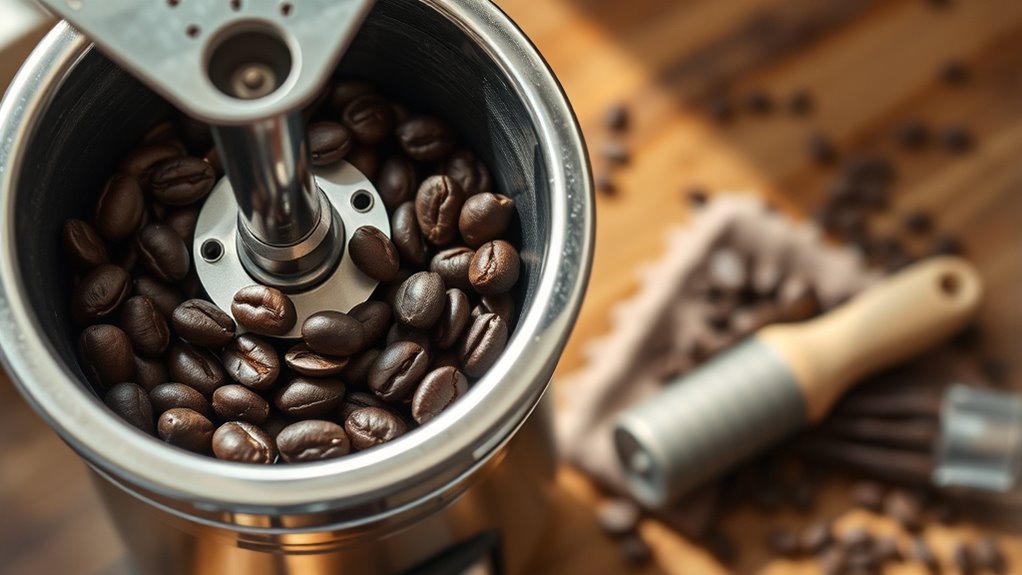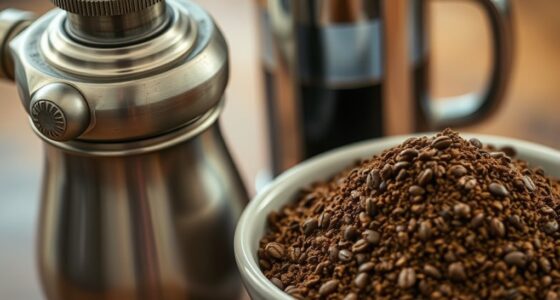To clean your coffee grinder properly, unplug it first and remove the hopper, emptying any remaining beans. Use a soft brush or cleaning brush to sweep away coffee oils, particles, and debris from the burrs and surrounding areas—avoid liquids or water to prevent rust. Run a small amount of dry cleaning powder or a coarse setting to dislodge residues, then wipe with a dry cloth. Staying consistent with these steps will keep your grinder performing at its best; explore more tips below.
Key Takeaways
- Unplug the grinder, remove the hopper, and empty remaining beans before cleaning.
- Use a dry brush or dedicated cleaning brush to sweep burrs and surrounding areas.
- Run a small amount of cleaning powder on a coarse setting to dislodge residues, then wipe exterior.
- Avoid water or liquids on burrs; opt for dry cleaning methods or specialized cleaning tablets.
- Regularly run blank grinds with clean beans after cleaning to clear residues and maintain performance.

Regular maintenance is essential to keep your coffee grinder functioning at its best and guarantee you get fresh, flavorful grounds every time. One of the most important aspects of maintenance involves paying attention to the grinder burrs. These burrs are responsible for crushing the beans evenly, ensuring consistent extraction and taste. Over time, coffee oils, particles, and debris can build up on the burrs, which not only affects flavor but can also strain the motor and reduce the grinder’s lifespan. Developing a regular cleaning schedule helps prevent this buildup, keeping your grinder in excellent condition.
Regularly cleaning burrs ensures fresh flavor and prolongs your coffee grinder’s lifespan.
A good cleaning schedule should involve inspecting and cleaning the grinder burrs at least once a month, especially if you use your grinder daily. If you’re making coffee multiple times a day, consider cleaning more frequently. To start, unplug the grinder to ensure safety. Remove the hopper and empty any remaining beans. Use a soft brush or a dedicated grinder cleaning brush to sweep away loose grounds from the burrs and surrounding areas. Avoid using water or liquids directly on the burrs, as this can cause damage or rust. Instead, opt for dry cleaning methods or specialized grinder cleaning tablets if your manufacturer recommends them.
Once you’ve brushed away loose debris, you might want to run a small amount of grinder cleaning powder through the machine. These powders are designed to absorb residual oils and grind residues. Run the grinder on a coarse setting to help dislodge any stubborn residues. Afterward, wipe down the exterior and any accessible parts with a dry cloth to remove dust or oil. Reassemble the grinder, then run a few blank grinds with clean beans to clear out any remaining cleaning residue. This ensures your grinder burrs are free of old oils and grounds, which can taint the flavor of your coffee. Regularly cleaning the burrs and maintaining other components will ensure optimal performance.
Maintaining a consistent cleaning schedule not only prolongs your grinder’s life but also guarantees the freshest coffee flavor possible. It’s tempting to overlook routine cleaning if your grinder seems to be working fine, but buildup can silently impair performance and taste. By sticking to a regular cleaning routine focused on the grinder burrs, you’ll notice more nuanced flavors in your coffee, and your machine will operate more smoothly. Remember, a clean grinder is a happy grinder, and it’s the key to brewing exceptional coffee every time. Regular cleaning also helps prevent clogging issues that can diminish the grinder’s efficiency and longevity.
Frequently Asked Questions
How Often Should I Replace My Coffee Grinder Blades?
You should replace your coffee grinder blades when you notice a decline in blade sharpness or when the grinding results become inconsistent. On average, the replacement frequency depends on usage, but generally, blades last about 6 to 12 months. Regularly check for dullness or buildup, and don’t wait until grinding becomes difficult. Keeping blades sharp ensures ideal flavor and performance in each brew.
Can I Use Soap to Clean My Coffee Grinder?
You shouldn’t use soap to clean your coffee grinder, as it can leave residues that affect your coffee’s flavor. Instead, use a damp cloth or cleaning brushes to wipe out the interior. If needed, you can run a small amount of rice or dry coffee grounds through the grinder to absorb oils and debris. Avoid dish soap, and always verify your grinder is completely dry before using it again.
Is It Safe to Submerge Parts of My Grinder in Water?
Ever wonder if submerging your coffee grinder parts in water is safe? Beware—water damage can ruin the electronic safety of your device, causing costly repairs or replacements. Typically, you shouldn’t dunk grinder parts in water, especially if they contain electronic components. Instead, focus on dry cleaning methods or damp cloths. Protect your investment by avoiding water exposure, keeping your grinder functioning smoothly without risking irreversible damage.
How Do I Prevent Stale Coffee Oils From Building Up?
To prevent stale coffee oils from building up and causing grinder odor, you should regularly clean your grinder. After each use, brush out leftover grounds and occasionally run a small amount of dry rice or grinder cleaner to absorb residual oils. This helps with oil buildup prevention and keeps your grinder smelling fresh. Consistent maintenance guarantees your coffee tastes great and your grinder stays in top condition.
What Are Signs That My Grinder Needs Professional Repair?
You might think your grinder just needs a quick clean, but if you notice persistent grinder noise or inconsistent grind size, it’s time to seek professional repair. These signs indicate internal issues that simple cleaning can’t fix. Ignoring them can damage your machine further. Trust a specialist to diagnose and fix the problem properly, ensuring your grinder works smoothly and delivers the perfect brew every time.
Conclusion
Think of your coffee grinder as a trusted garden tool; with regular care and cleaning, it stays sharp and ready to nurture your mornings. Neglect it, and it becomes dull and ineffective, spoiling your brew. By maintaining your grinder, you’re tending a delicate garden that rewards you with rich, flavorful coffee. So, treat your grinder like a prized plant—water it with cleaning, prune away residue, and watch your mornings flourish anew.









